Danai Koutra
Beyond Unimodal Boundaries: Generative Recommendation with Multimodal Semantics
Mar 30, 2025Abstract:Generative recommendation (GR) has become a powerful paradigm in recommendation systems that implicitly links modality and semantics to item representation, in contrast to previous methods that relied on non-semantic item identifiers in autoregressive models. However, previous research has predominantly treated modalities in isolation, typically assuming item content is unimodal (usually text). We argue that this is a significant limitation given the rich, multimodal nature of real-world data and the potential sensitivity of GR models to modality choices and usage. Our work aims to explore the critical problem of Multimodal Generative Recommendation (MGR), highlighting the importance of modality choices in GR nframeworks. We reveal that GR models are particularly sensitive to different modalities and examine the challenges in achieving effective GR when multiple modalities are available. By evaluating design strategies for effectively leveraging multiple modalities, we identify key challenges and introduce MGR-LF++, an enhanced late fusion framework that employs contrastive modality alignment and special tokens to denote different modalities, achieving a performance improvement of over 20% compared to single-modality alternatives.
Unleashing the Power of LLMs as Multi-Modal Encoders for Text and Graph-Structured Data
Oct 15, 2024



Abstract:Graph-structured information offers rich contextual information that can enhance language models by providing structured relationships and hierarchies, leading to more expressive embeddings for various applications such as retrieval, question answering, and classification. However, existing methods for integrating graph and text embeddings, often based on Multi-layer Perceptrons (MLPs) or shallow transformers, are limited in their ability to fully exploit the heterogeneous nature of these modalities. To overcome this, we propose Janus, a simple yet effective framework that leverages Large Language Models (LLMs) to jointly encode text and graph data. Specifically, Janus employs an MLP adapter to project graph embeddings into the same space as text embeddings, allowing the LLM to process both modalities jointly. Unlike prior work, we also introduce contrastive learning to align the graph and text spaces more effectively, thereby improving the quality of learned joint embeddings. Empirical results across six datasets spanning three tasks, knowledge graph-contextualized question answering, graph-text pair classification, and retrieval, demonstrate that Janus consistently outperforms existing baselines, achieving significant improvements across multiple datasets, with gains of up to 11.4% in QA tasks. These results highlight Janus's effectiveness in integrating graph and text data. Ablation studies further validate the effectiveness of our method.
Unveiling the Impact of Local Homophily on GNN Fairness: In-Depth Analysis and New Benchmarks
Oct 05, 2024Abstract:Graph Neural Networks (GNNs) often struggle to generalize when graphs exhibit both homophily (same-class connections) and heterophily (different-class connections). Specifically, GNNs tend to underperform for nodes with local homophily levels that differ significantly from the global homophily level. This issue poses a risk in user-centric applications where underrepresented homophily levels are present. Concurrently, fairness within GNNs has received substantial attention due to the potential amplification of biases via message passing. However, the connection between local homophily and fairness in GNNs remains underexplored. In this work, we move beyond global homophily and explore how local homophily levels can lead to unfair predictions. We begin by formalizing the challenge of fair predictions for underrepresented homophily levels as an out-of-distribution (OOD) problem. We then conduct a theoretical analysis that demonstrates how local homophily levels can alter predictions for differing sensitive attributes. We additionally introduce three new GNN fairness benchmarks, as well as a novel semi-synthetic graph generator, to empirically study the OOD problem. Across extensive analysis we find that two factors can promote unfairness: (a) OOD distance, and (b) heterophilous nodes situated in homophilous graphs. In cases where these two conditions are met, fairness drops by up to 24% on real world datasets, and 30% in semi-synthetic datasets. Together, our theoretical insights, empirical analysis, and algorithmic contributions unveil a previously overlooked source of unfairness rooted in the graph's homophily information.
On the Impact of Feature Heterophily on Link Prediction with Graph Neural Networks
Sep 26, 2024
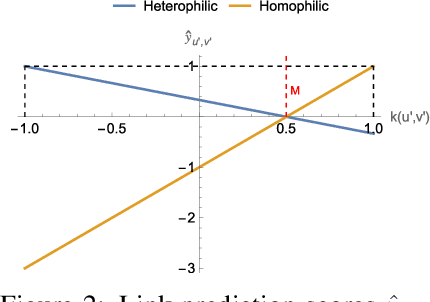
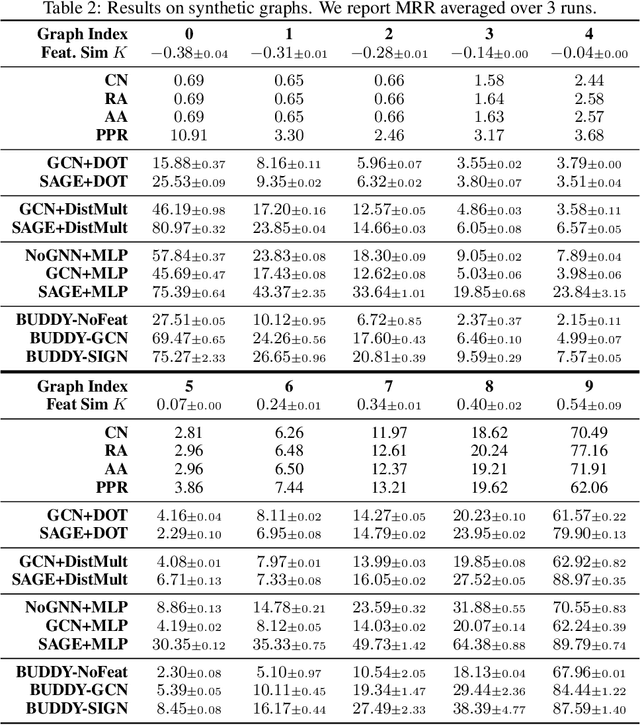
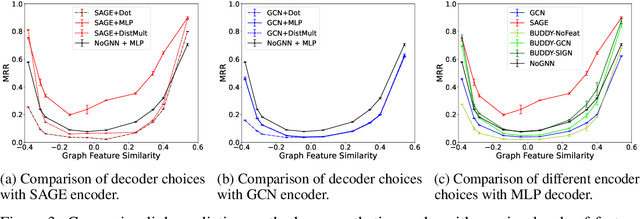
Abstract:Heterophily, or the tendency of connected nodes in networks to have different class labels or dissimilar features, has been identified as challenging for many Graph Neural Network (GNN) models. While the challenges of applying GNNs for node classification when class labels display strong heterophily are well understood, it is unclear how heterophily affects GNN performance in other important graph learning tasks where class labels are not available. In this work, we focus on the link prediction task and systematically analyze the impact of heterophily in node features on GNN performance. Theoretically, we first introduce formal definitions of homophilic and heterophilic link prediction tasks, and present a theoretical framework that highlights the different optimizations needed for the respective tasks. We then analyze how different link prediction encoders and decoders adapt to varying levels of feature homophily and introduce designs for improved performance. Our empirical analysis on a variety of synthetic and real-world datasets confirms our theoretical insights and highlights the importance of adopting learnable decoders and GNN encoders with ego- and neighbor-embedding separation in message passing for link prediction tasks beyond homophily.
Multimodal Graph Benchmark
Jun 24, 2024



Abstract:Associating unstructured data with structured information is crucial for real-world tasks that require relevance search. However, existing graph learning benchmarks often overlook the rich semantic information associate with each node. To bridge such gap, we introduce the Multimodal Graph Benchmark (MM-GRAPH), the first comprehensive multi-modal graph benchmark that incorporates both textual and visual information. MM-GRAPH surpasses previous efforts, which have primarily focused on text-attributed graphs with various connectivity patterns. MM-GRAPH consists of five graph learning datasets of various scales that are appropriate for different learning tasks. Their multimodal node features, enabling a more comprehensive evaluation of graph learning algorithms in real-world scenarios. To facilitate research on multimodal graph learning, we further provide an extensive study on the performance of various graph neural networks in the presence of features from various modalities. MM-GRAPH aims to foster research on multimodal graph learning and drive the development of more advanced and robust graph learning algorithms. By providing a diverse set of datasets and benchmarks, MM-GRAPH enables researchers to evaluate and compare their models in realistic settings, ultimately leading to improved performance on real-world applications that rely on multimodal graph data.
Multi-Stage Balanced Distillation: Addressing Long-Tail Challenges in Sequence-Level Knowledge Distillation
Jun 19, 2024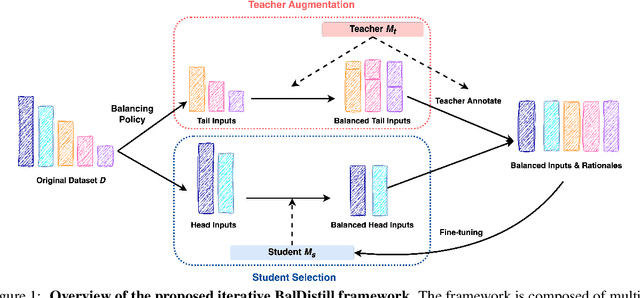
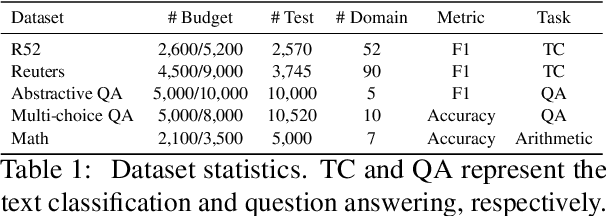
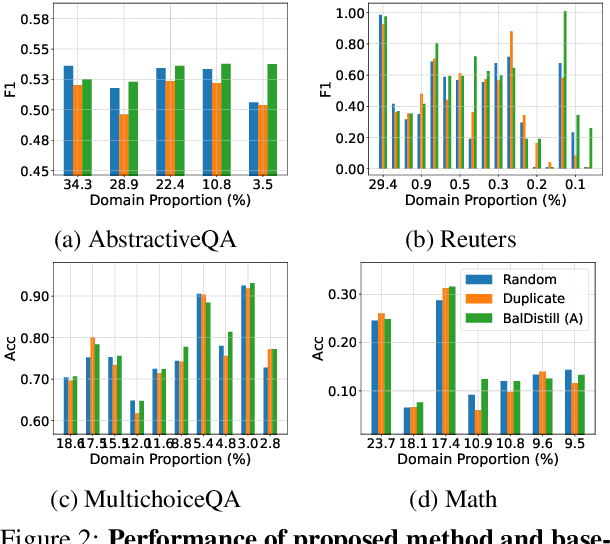

Abstract:Large language models (LLMs) have significantly advanced various natural language processing tasks, but deploying them remains computationally expensive. Knowledge distillation (KD) is a promising solution, enabling the transfer of capabilities from larger teacher LLMs to more compact student models. Particularly, sequence-level KD, which distills rationale-based reasoning processes instead of merely final outcomes, shows great potential in enhancing students' reasoning capabilities. However, current methods struggle with sequence level KD under long-tailed data distributions, adversely affecting generalization on sparsely represented domains. We introduce the Multi-Stage Balanced Distillation (BalDistill) framework, which iteratively balances training data within a fixed computational budget. By dynamically selecting representative head domain examples and synthesizing tail domain examples, BalDistill achieves state-of-the-art performance across diverse long-tailed datasets, enhancing both the efficiency and efficacy of the distilled models.
Large Generative Graph Models
Jun 07, 2024Abstract:Large Generative Models (LGMs) such as GPT, Stable Diffusion, Sora, and Suno are trained on a huge amount of language corpus, images, videos, and audio that are extremely diverse from numerous domains. This training paradigm over diverse well-curated data lies at the heart of generating creative and sensible content. However, all previous graph generative models (e.g., GraphRNN, MDVAE, MoFlow, GDSS, and DiGress) have been trained only on one dataset each time, which cannot replicate the revolutionary success achieved by LGMs in other fields. To remedy this crucial gap, we propose a new class of graph generative model called Large Graph Generative Model (LGGM) that is trained on a large corpus of graphs (over 5000 graphs) from 13 different domains. We empirically demonstrate that the pre-trained LGGM has superior zero-shot generative capability to existing graph generative models. Furthermore, our pre-trained LGGM can be easily fine-tuned with graphs from target domains and demonstrate even better performance than those directly trained from scratch, behaving as a solid starting point for real-world customization. Inspired by Stable Diffusion, we further equip LGGM with the capability to generate graphs given text prompts (Text-to-Graph), such as the description of the network name and domain (i.e., "The power-1138-bus graph represents a network of buses in a power distribution system."), and network statistics (i.e., "The graph has a low average degree, suitable for modeling social media interactions."). This Text-to-Graph capability integrates the extensive world knowledge in the underlying language model, offering users fine-grained control of the generated graphs. We release the code, the model checkpoint, and the datasets at https://lggm-lg.github.io/.
LinkGPT: Teaching Large Language Models To Predict Missing Links
Jun 07, 2024Abstract:Large Language Models (LLMs) have shown promising results on various language and vision tasks. Recently, there has been growing interest in applying LLMs to graph-based tasks, particularly on Text-Attributed Graphs (TAGs). However, most studies have focused on node classification, while the use of LLMs for link prediction (LP) remains understudied. In this work, we propose a new task on LLMs, where the objective is to leverage LLMs to predict missing links between nodes in a graph. This task evaluates an LLM's ability to reason over structured data and infer new facts based on learned patterns. This new task poses two key challenges: (1) How to effectively integrate pairwise structural information into the LLMs, which is known to be crucial for LP performance, and (2) how to solve the computational bottleneck when teaching LLMs to perform LP. To address these challenges, we propose LinkGPT, the first end-to-end trained LLM for LP tasks. To effectively enhance the LLM's ability to understand the underlying structure, we design a two-stage instruction tuning approach where the first stage fine-tunes the pairwise encoder, projector, and node projector, and the second stage further fine-tunes the LLMs to predict links. To address the efficiency challenges at inference time, we introduce a retrieval-reranking scheme. Experiments show that LinkGPT can achieve state-of-the-art performance on real-world graphs as well as superior generalization in zero-shot and few-shot learning, surpassing existing benchmarks. At inference time, it can achieve $10\times$ speedup while maintaining high LP accuracy.
Accurate and Scalable Estimation of Epistemic Uncertainty for Graph Neural Networks
Jan 07, 2024



Abstract:While graph neural networks (GNNs) are widely used for node and graph representation learning tasks, the reliability of GNN uncertainty estimates under distribution shifts remains relatively under-explored. Indeed, while post-hoc calibration strategies can be used to improve in-distribution calibration, they need not also improve calibration under distribution shift. However, techniques which produce GNNs with better intrinsic uncertainty estimates are particularly valuable, as they can always be combined with post-hoc strategies later. Therefore, in this work, we propose G-$\Delta$UQ, a novel training framework designed to improve intrinsic GNN uncertainty estimates. Our framework adapts the principle of stochastic data centering to graph data through novel graph anchoring strategies, and is able to support partially stochastic GNNs. While, the prevalent wisdom is that fully stochastic networks are necessary to obtain reliable estimates, we find that the functional diversity induced by our anchoring strategies when sampling hypotheses renders this unnecessary and allows us to support G-$\Delta$UQ on pretrained models. Indeed, through extensive evaluation under covariate, concept and graph size shifts, we show that G-$\Delta$UQ leads to better calibrated GNNs for node and graph classification. Further, it also improves performance on the uncertainty-based tasks of out-of-distribution detection and generalization gap estimation. Overall, our work provides insights into uncertainty estimation for GNNs, and demonstrates the utility of G-$\Delta$UQ in obtaining reliable estimates.
Graph Coarsening via Convolution Matching for Scalable Graph Neural Network Training
Dec 24, 2023Abstract:Graph summarization as a preprocessing step is an effective and complementary technique for scalable graph neural network (GNN) training. In this work, we propose the Coarsening Via Convolution Matching (CONVMATCH) algorithm and a highly scalable variant, A-CONVMATCH, for creating summarized graphs that preserve the output of graph convolution. We evaluate CONVMATCH on six real-world link prediction and node classification graph datasets, and show it is efficient and preserves prediction performance while significantly reducing the graph size. Notably, CONVMATCH achieves up to 95% of the prediction performance of GNNs on node classification while trained on graphs summarized down to 1% the size of the original graph. Furthermore, on link prediction tasks, CONVMATCH consistently outperforms all baselines, achieving up to a 2x improvement.
 Add to Chrome
Add to Chrome Add to Firefox
Add to Firefox Add to Edge
Add to Edge